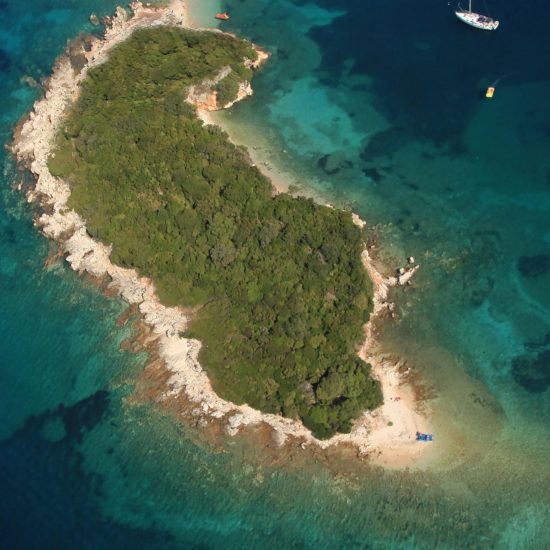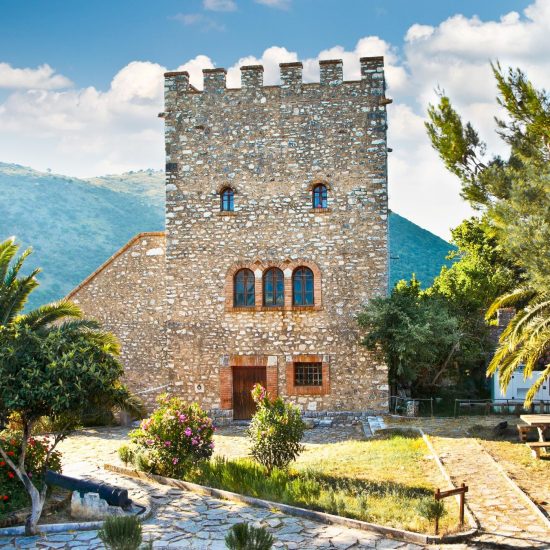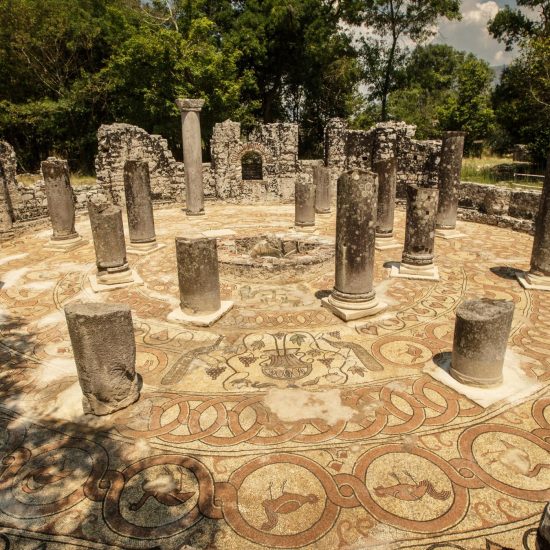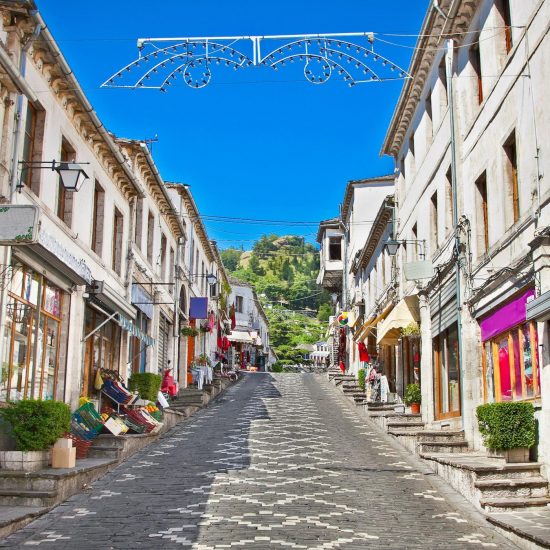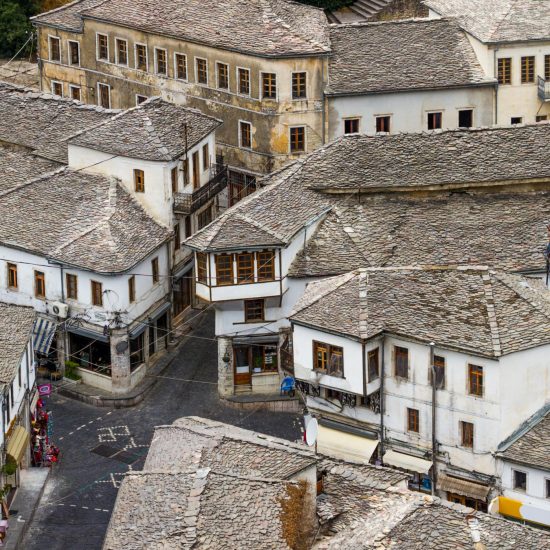Saranda – Ksamil
Saranda, the seaport of southern Albania, is located on a natural shelf overlooking the island of Corfu. There are daily ships connecting Saranda with this Greek island. The name Saranda comes from the old Christian monastery “Forty Saints” (in Greek, Saranda means “forty”). The ruins of the monastery lay at Qafa e Gjashtës, at the entrance to the city. Before Byzantine rule, Saranda was called the ancient Greek name “Onchesmos” in honor of the father of the Trojan prince Aeneas, who was born on Mount Ida by the Greek goddess Aphrodite.
The city is located on the southern tip of the Ionian coast of Albania and has a very pleasant avenue full of palm trees and pebbly beaches. In the center of the city stand the ruins of the ancient city of Onkhezmi, destroyed in the 5th century AD by barbarian invasions. In 2002, a synagogue was discovered on the same site. Just 2 km south of Saranda, on top of a massive hill, is Lecours Castle. The castle was built by Sultan Suleiman during his military campaign in Corfu. Today, the fortress houses a restaurant that offers rich cuisine and captivating views of the deep blue Ionian Sea.
Heading south, the coastline changes its appearance. In the Ksamil region, four small islands emerge, covered with Mediterranean vegetation and surrounded by magnificent marine flora and fauna. The salt lake, a lagoon of tectonic origin, lies inland near Butrint. In ancient times, it was known as Pelodes and was connected to the sea through the 3.6 km long Vivar Canal. Here tourists can find a large number of sea birds.
Butrint
South of Lake Butrint, 18 km from Saranda, is the ancient city of Butrint, the most important archaeological site in Albania and a UNESCO World Heritage Site. The name Butrint is well known since the 7th century BC as the most important city of Epirus. According to Dionysius of Halicarnassus, the building of Butrint was associated with the presence of the Trojan prince Aeneas during his journey to the temple of Dodona. He paid tribute to the oracle of Dodona by sacrificing a bull (in Greek, Butros) at the place where the city of Butrint began to rise. The visit of Aeneas to Butrint is also mentioned by the Roman poet Virgil in his poem “Aeneid”.
There are many attractions in Butrint. The most interesting are the Temple of Asclepius (the god of good health; 2nd century BC), a theater with 1500 seats from the 3rd century BC. (which now hosts an annual International Theater Festival), Epiphany (a paleo-Christian attraction). ), as well as the nymphet, the baths, the stoa (colonade), the lake gate, the Lion Gate, the Venetian fortress of Ali Pasha and many others. Apart from its historical value, Butrint is known for its excellent ecological system. The ruins and buildings of the city stand among the amazing subtropical jungle with a lot of laurel and other tall trees.
Girokastra
When you leave Saranda, the national highway will take you to the unique city of Gjirokastra, located just 56 km away. On the way, just 10 km from Saranda, travelers will find Finiki, the capital of the Kingdom of Epirus (and at that time it was called Foinike), founded in the 3rd-2nd centuries BC on the territory of Kaonia.
The historian Polybus called it “the richest and most fortified city of Epirus”. Southwest of Finiki, in the hilltop village of Mesopotamus, is the Shen Kolli Church, built during the Byzantine period. One of the most pleasant surprises of this trip is Syri i Kaltër (Blue Eye), a powerful natural spring that has created a small lake of crystal clear water, similar to a giant eye. The specialty of the neighboring restaurant is lake trout. Passing Qafa e Muzinës you will come across the Gjirokaster-Kakavie national highway. As you leave the village of Dropulli on the left, the museum city of Gjirokastra, built on the eastern slope of Mali-i-Jere, unfolds in front of you. Due to its architecture, Gjirokastra is also known as the “City of Stone” or the “City of a Thousand Steps”. It is an ancient city with early inhabitants, in which a fortress was later built, serving as the center of the city. What most attracts visitors to Gjirokastra are the traditional tall stone houses resembling small fortresses, together forming a unique architectural complex. Due to its architectural uniqueness, Gjirokastra is included in the UNESCO World Heritage List. The main building is the city’s fortress, called the Arjiro Fortress – the famous story of the famous princess Arjiro gave rise to the name Arjirokastro, given to the city in 1336.
The Museum of Weapons, located inside the fortress, displays weapons from the Paleolithic period to World War II. During your stay in Gjirokaster you can also visit the Museum of Ethnography. Gjirokastra is known for its dishes such as shapkat, laropit, birek (different types of pies) and several dairy products known throughout Albania. Some of the most interesting buildings and places you can visit are the Sophrates Theatre, the ancient city of Antigone, Tekke Melan and the village of Sotira.
The Sophrates Theatre, which is part of the Roman city of Adrianople, developed from the 2nd century AD, contained 4,000 spectators in twenty-seven tiers. Antigone is an ancient city from the 2nd century BC and is currently an archaeological park located in the Lunxkheri region, east of Gjirokastra and near the village of Sarakinisht. It is believed that the city was founded by King Pyrrhus, who named the city in honor of his wife Antigone. The city had 35 hectares; its ruins are located on a hill at an altitude of 600 m above sea level. Tourists can visit the remains and fragments of the surrounding wall, agora and table of the city, which are 59 m long and 9 m wide. It should be mentioned that in the area, archaeologists have discovered a seven-inch bronze statue representing Poseidon, the god of the sea and the Sphinx of Antigone.
Both objects are on display at the National Historical Museum in Tirana. Tekke Melan can be found just 4 km south of the small town of Libochov. This religious building of the Bektashi sect is open to everyone, and guests are not only received, but also received with special hospitality. The village of Sotira is located in the Dropulli region, inhabited by a Greek minority. It is a mountain village of rare beauty with small stone houses, surrounded by the fir forest of Sotira and many water sources. The Dropulli region is known throughout Albania for its beautiful women’s folk costumes and elegant dances.


